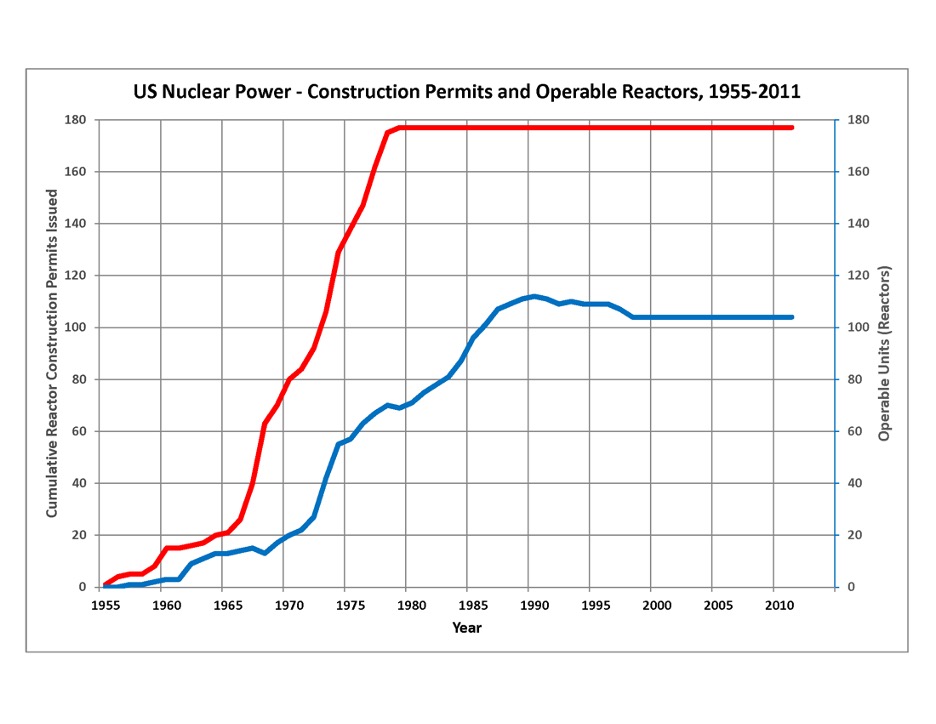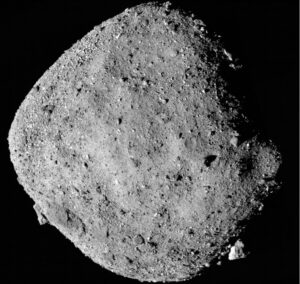
Figure 1: Shown by the red line, the sharp increase in the number of permits issued for nuclear reactors stopped completely after the partial meltdown of the nuclear reactor in the Three Mile Island accident of 1979. Consequently, the operational units of nuclear energy, shown by the blue line, saw a continued rise due to earlier construction permits being completed but has also remained constant since 2000. It is believed by some that the new small modular reactor designed by NuScale Power will be the inflection point that returns these trends to growth rather than stagnation
Source: Wikimedia Commons
Nuclear reactors have received much criticism in recent years. From concerns over the safety and the up to $9 billion price tag that construction of the standard 1,000 megawatt nuclear reactor requires, there are many reasons why the shift in the search for low-carbon emission energy production has moved away from nuclear and more towards solar and wind.2 However, a new nuclear reactor design recently approved by the U.S. Nuclear Regulatory Commission (NRC) may be the first steps towards a bright future for the nuclear industry.1 This new design has been named the small modular reactor (SMR), and is quite literally a smaller version of the previous nuclear reactor designs. This smaller-scale reactor, produced by the Portland based company NuScale Power, was designed specifically to allow for faster construction speeds, lower costs, and improved safety standards.1
While the country’s interest in generating nuclear power has diminished significantly since the ‘70s, the importance of these reactors is significant. Though there has not been a newly constructed nuclear plant in the US for over three decades, there are currently almost 100 large reactors in the country today that collectively supply 98 gigawatts of electricity. This capacity represents almost twenty percent of the country’s current electricity consumption, and NuScale wants to push this percentage even higher. CEO and Chairman of NuScale, John Hopkins, expects that the SMR design will be an impetus for further nuclear power development throughout the US. The company estimates that it will sell anywhere from 674 to 1,682 reactors from 2023 to 2042. Currently, the SMR design produces up to 50 megawatts of electricity and NuScale’s optimistic estimate puts total production at over 80 gigawatts of electricity – this will almost double the electrical output currently supplied by nuclear reactors.1
NuScale has already started to generate success, with their first reactor scheduled to be completed for Utah Associate Municipal Power Systems (UAMPS) by 2027 and operational in 2029. Another eleven reactors are planned to be delivered to UAMPS by 2030. However, a few municipalities expected to receive the power from NuScale’s design have already cancelled their agreements due to several concerns.1
These concerns have mainly been due to price and safety. Though producing a fraction of the power that large-scale reactors provide (50 MW v. 1,000 MW), SMRs are expected to hold an initial price tag of $6 billion; when compared to the $9 billion price tag of the large reactors with a larger power capacity, this price seems like an irrational investment. These initial costs, coupled with the high operating costs of these reactors, have led to nuclear energy being almost three times as expensive than solar and four times as expensive as wind on a per megawatt hour basis ($112 v. $46 v. $30).3 That being said, Hopkins and the NuScale team expect to increase the efficiency of these reactors, with a 60-megawatt SMR being introduced as early as 2022, but even that will not necessarily be enough to overcome the safety concerns that plague the current SMR design.1
Though the NRC issued NuScale a design approval and final safety evaluation report (FSER), this does not mean that the firm has clearance to start building. It only means utility companies can apply to the NRC to build the SMR design. There are still many loose ends for the design that still makes safety uncertain. The NRC even pointed out that the design still holds “several potentially risk-significant items,” including a lack of clarity on how the nuclear waste would be safely disposed. The agency has stated that these safety considerations will be assessed intensely when granting site-specific licensing.1
Therefore, while the SMR is a big step for the nuclear industry that could spell the end of a long drought in nuclear reactor construction, there is still a long road ahead to make its design practical. From cost considerations to basic safety measures, nuclear scientists and engineers have much to work on before NuScale’s first construction deadline in 2027. However, with more attention and support, the nuclear sector could be the cost and carbon efficient solution of the future.1
References
- Levitan, D. (2020, September 9). First U.S. Small Nuclear Reactor Design Is Approved. Scientific American. https://www.scientificamerican.com/article/first-u-s-small-nuclear-reactor-design-is-approved/
- Nuclear Energy in the U.S.: Expensive Source Competing with Cheap Gas and Renewables. (2017, December 22). Climate Nexus. https://climatenexus.org/climate-news-archive/nuclear-energy-us-expensive-source-competing-cheap-gas-renewables/
- Nuclear Power Economics | Nuclear Energy Costs—World Nuclear Association. (n.d.). Retrieved September 13, 2020, from https://www.world-nuclear.org/information-library/economic-aspects/economics-of-nuclear-power.aspx
Related Posts
George Washington Carver: “The Peanut Man”
Figure 1: George Washington Carver: “The Peanut Man” (Photograph ca. 1910)...
Read MoreThe Environmental Consequences of Civil Wars
Figure 1: This is the flag of Angola, the model...
Read MoreDev Kapadia



